|
K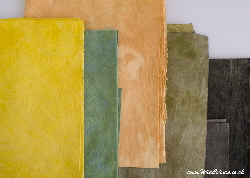 nown as a symbol of love in antiquity, the pomegranate has been a popular fruit for thousands of years. Dyers use the rind to produce golden yellows, greens, greys and blacks. nown as a symbol of love in antiquity, the pomegranate has been a popular fruit for thousands of years. Dyers use the rind to produce golden yellows, greens, greys and blacks.
A. Biology of Pomegranate
B. History of Pomegranate as a dye
C. Dyeing with Pomegranate
A. Biology of Pomegranate
Pomegranate is a deciduous spiny shrub or small tree belonging to the family Lythraceae. This attractive shrub is hardy, drought resistant and long lived (up to 200 years). Pomegranate is cultivated in warm countries all over the world.
The fruit is spherical, up to 12 cm in diameter and has a tough leathery skin. Inside there are many seeds, each surrounded by a ruby-red fleshy pulp. The flesh can be made into juice and the syrup grenadine, whilst the seeds can be ground and made into a spice called anardana. The leftover rind is not wasted but used as a dye. One tree yields about 1 kilo of dried rind a year.
B. History of Dyeing with Pomegranate
P
|
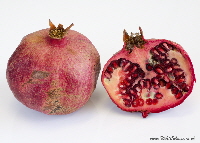
|
|
pomegranate fruit
|
|
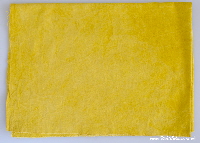
|
|
fabric dyed with pomegranate
|
|
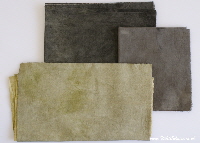
|
|
dyed with pomegranate & iron
|
|
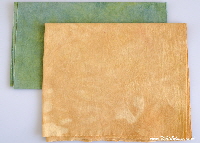
|
|
dyed with pomegranate & indigo (top) or lac (bottom)
|
|
omegranate is one of the oldest fruits in cultivation and its rind has been used as a dye by carpet makers for millennia. It was a symbol of love in antiquity and even features in an ancient Egyptian love song.
The common name ‘pomegranate’ means seeded apple in Latin. The city of Granada in Spain was named after the pomegranate fruit. In Rome it was known as punica, as it was introduced from the Punic nation (now Tunisia) and this is why the scientific (generic) name is ‘Punica’.
C. Dyeing with pomegranate
This dye is high in tannin (19 to 26%), therefore it works particularly well with cotton and other plant fibres but you can also use it to dye wool and silk. You will get yellow fawn when using pomegranate without a mordant and golden yellows with a mordant. With the addition of iron, you will get mossy greens, greys and blacks. You can over-dye it with indigo to make beautiful dark greens. Pomegranate rinds are popular for contact dyeing (ecoprints).
Immature fruits give pale yellows, while ripe fruits give golden yellows. Most dyers buy dry chopped pomegranate rinds which come from ripe fruits. However, if you have access to a pomegranate tree you can use fresh fruit. If the fruits are small, use the whole fruit broken up. If you have access to large fruits from a market, eat the fleshy pulp and use the rind.
a) Yellows from pomegranate:
1. Soak the pomegranate rinds in hot water overnight. Use the same amount of dried rind as fibre (for example if your piece of cotton fabric weighs 80 grams, use 80 grams of pomegranate rind).
2. Simmer the rind for an hour the next day.
3. Let it cool down, strain the rind and save the liquid.
4. Add your wet mordanted fibre to the dye pot. Gently simmer for an hour.
5. Let the fibre cool in the dye bath.
Note: If you are dyeing cotton fabric and you want a mottled effect, you don’t need to strain the rind, just add the fabric after you simmered the rinds, and simmer everything for another hour. Let the fabric cool down in the pot and then take it out. Let it dry outside and then shake all the bits out.
b) Mossy greens, greys and blacks from pomegranate:
Pomegranate’s high tannin content means that it reacts with iron, turning to deep moss green, and even to greys and blacks. Just remember that too much iron damages wool, silk and other protein fibres.
1. Mordant your fabric and dye it yellow using the instructions above.
2. Dissolve a tiny pinch of iron in hot water and add it to a container full of hot water and stir well. I keep an old saucepan and spoon just for using with iron, to avoid it interfering with other dyes.
3. Wearing gloves, add your yellow wet fabric and move it about. The colour will quickly change from yellow to mossy green. Take the fabric out of the pot as soon as it reaches the colour you want.
For greys add a pinch of iron at a time, until you get the colour you want. For blacks add about a teaspoon of iron and leave the fabric in the pot for at least an hour.
c) Other colours from pomegranate:
For bright greens, first dye your fabric pale to medium blue with indigo and then mordant it and overdye it with pomegranate.
For peach colours, dye your fabric yellow with pomegranate and overdye it with a pinch of lac extract.
Top of page
|